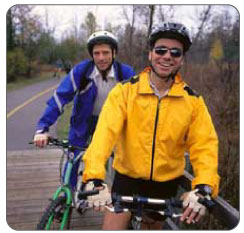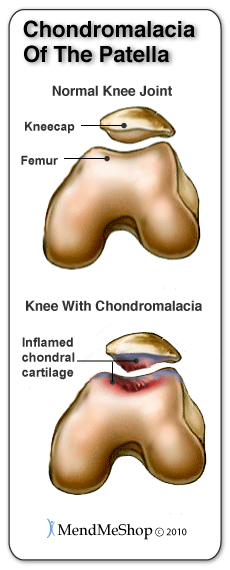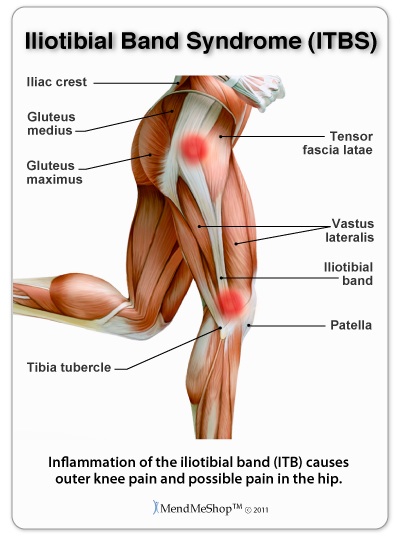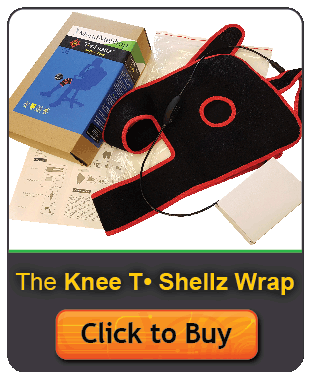
Cycling is a low impact activity and is considered a good exercise option for people with knee injuries or conditions. However, the repetitive motion of pedaling can lead to chronic overuse injuries in the knees. In fact, 40%-60% of cyclists, experience knee pain. Knee pain from cycling can be caused by the improper fit of the bike, anatomical factors, or training issues that put excess strain on the knees or leg muscles.
The 2 most common causes of knee pain in cyclists is patella Chondromalacia and Iliotibial Band Syndrome (ITBS). Patella Chondromalacia causes pain beneath and around the kneecap. With ITBS you will experience pain in the lateral (outside) knee and possibly even the hip. Repetitive knee motions that occur when cycling may also lead to painful knee conditions such as patellar tendinitis (pain occurs above and below the kneecap) and pes anserine bursitis (pain occurs below and on the inside of the knee).

Patellar chondromalacia, also known as runner's knee or patellofemoral syndrome, occurs when the smooth cartilage enabling the femur and kneecap to glide smoothly over one another becomes irritated or damaged and begins to deteriorate. The cartilage may soften, crack or blister resulting in pain and inflammation.
This damage is caused by regular wear and tear or by repetitive trauma due to unbalanced leg muscles or tightening of muscles from training and the patella (kneecap) becoming misaligned.
Patellar Chondromalacia patients complain of pain or discomfort under or around the sides of the kneecap. The pain often increases when using stairs, running up hill, jumping, getting out of a chair or when participating in other activities that put weight on the knee. A grinding feeling and/or sound may also occur when trying to straighten the knee. Swelling may also occur along with the pain and inflammation in the knee joint. These symptoms are caused by the degeneration of cartilage and the resulting irritation. Fortunately, doctors believe the damage can be repaired.
Iliotibial band syndrome occurs when the IT band becomes irritated, inflamed and tight. Excessive rubbing of the IT band over the tibial tubercle (bony prominence at the outside of the knee) is a common cause of the irritation that leads to inflammation of the tendon, tightness along the outer leg, and knee pain. In addition to knee pain, soreness in the hip may also occur.

Once inflammation in the IT band is reduced and healing begins, scar tissue begins to develop on the iliotibial tract. This scar tissue is tough and inflexible and it stops the muscles attached to the IT band from moving smoothly. This causes further pain at the knee and the tightness is usually felt in the hip (at the top of the iliotibial tract) and down the leg to the knee.
ITBS symptoms include pain on the outside of the knee that develops while cycling and subsides shortly after finishing. This pain eventually becomes more constant and is noticeable when doing other activities such as running, walking, and climbing up or going down stairs. As the iliotibial band becomes tighter, stiffness in the hip and outer thigh will occur. Following activity, pain and swelling around the knee usually becomes worse.
Whether your knee pain is caused by patellar chondromalacia or ITBS, if these symptoms become chronic, weakened quadriceps muscles may allow the leg to give out which can cause further injury to the knee or leg.
When inflammation and tenderness occur at the front or lateral side of the knee, an initial program of rest, elevation and cold compression is recommended to reduce the pain and inflammation. Once inflammation has been reduced, Circulation Boost (Circulatory Boost) can speed healing and nourish muscle tissue to prepare it for strengthening and exercise.
To prevent further damage to the cartilage avoid exercises and activities, like cycling, that irritate the patella until the problem is corrected. If the cause of your pain is misalignment of the kneecap, selective exercises that strengthen the inner quadriceps muscles are recommended to straighten the movement of the patella over the femur. If improper bike fit has caused excess stress on the kneecap and femur, take corrective action and get your bike adjusted by a professional so it fits your body properly. Finally, if training issues are the cause, start cycling less intensely or for shorter distances and work up slowly to your desired level.
Cold works by interrupting and slowing nerve and tissue function in the damaged area. This is important because once blood vessels are damaged, they can no longer carry oxygenated blood to the damaged tissue and so these tissues continue to break-down.
By limiting the amount of damage done to your tissue, you limit the amount of healing that needs to occur. This is a very important step to treat your damaged knee quickly and reduce pain from inflammation.

Once inflammation and swelling has been alleviated, nourishing and strengthening the muscle tissue around the knee joint and in the upper leg is recommended to realign the patella or strenthen the tendons and muscles surrounding the patella. Circulation Boost, via use of the Knee TShellz Wrap® will increase blood flow in your leg while helping improve the flexibility of soft tissue.
When you stop moving your knee because it hurts the amount of blood that flows naturally to your knee joint is reduced, limiting your body's natural ability to heal itself.
Circulatory Boost (via use of the Knee TShellz Wrap®) compliments your body's natural healing process by promoting blood flow while you give your knee the rest it needs. Energy emitted from the Energy Pad stimulates blood flow to your knee, more than your body would ever be able to generate on it's own, giving your body the boost it needs to continue the reconditioning process. This enhanced blood flow helps speed tissue repair, whisk away toxins and dead tissue, and rejuvenates soft tissue for improved elasticity. Circulatory Boost enhances your body's own healing process by simply increasing the amount of blood that flows to your leg and knee to improve the health of your tissue by delivering an abundance of nutrients to the area.
TShellz Wraps® = Circulation Boost
In addition, the improved blood flow helps reduce the risk of atrophy in your muscles. When you stop moving your leg and knee due to pain, your muscles and other tissue can become weaker and dead tissue and toxins in the area can cause further tissue deterioration - this can lead to atrophy (muscle weakness and/or deterioration) in your quadriceps, hamstrings and other leg muscles. The Leg/Arm TShellz Wrap® is an amazing tool that can be used to treat both the upper and lower leg (as well as the arm).
By clearing the area of toxins and increasing the amount of oxygen and nutrients to your IT band, leg muscles, and knee the risk of atrophy is greatly reduced. Keeping your knee and leg tissue as healthy as possible throughout the healing process will allow you to improve strength again once your pain has gone and your knee has healed.
During your recovery, you will probably have to modify and/or eliminate any activities that cause pain or discomfort in your knee area until your pain and inflammation settle. With these easy to use home therapies - the TShellz Wrap® and a Cold Compress or Ice Pack, you will notice an incredible improvement in a reduction of pain and an increased range of motion. The more diligent you are with your treatment and rehabilitation, the faster you will see successful results and the sooner you can return to the activities you enjoy - without pain!
Click HERE to Go To Our Online Store We take all major credit cards and Paypal. If you are on your mobile phone, Click to Call Our Office (toll free continental NA).
Our customer service lines are open 5 days a week helping people understand their injuries and how to treat them. Simply call toll free 1-866-237-9608 to talk with one of our knowledgeable Product Advisors. They have the ability to answer questions and even put together a treatment plan for you.
Product Advisors are available 9:00 am to 5:00 pm Eastern Standard Time Monday to Friday.
Learn more about Knee Surgery and Post-Surgery Recovery
Learn more about how the TShellz Wrap® stimulates blood flow.
Learn more about Ice vs Heat Treatments for Knee Strain
During your recovery, you will probably have to modify and/or eliminate any activities that cause pain or discomfort at the location of your soft tissue injury until the pain and inflammation settle. The more diligent you are with your treatment and rehabilitation, the faster you will see successful results!
Please be aware that this information is neither intended nor implied to be a substitute for professional medical advice. CALL YOUR HEALTHCARE PROVIDER IMMEDIATELY IF YOU THINK YOU MAY HAVE A MEDICAL EMERGENCY. Always seek the advice of your physician or other qualified health provider before using any of our outstanding products to make sure they are right for you and your condition or if you have any questions regarding a medical condition. Always see your doctor for a proper diagnosis as there are often many injuries and conditions (some very serious) that could be the cause of your pain.
© 2025 In.Genu Design Group, Inc. Contact Us